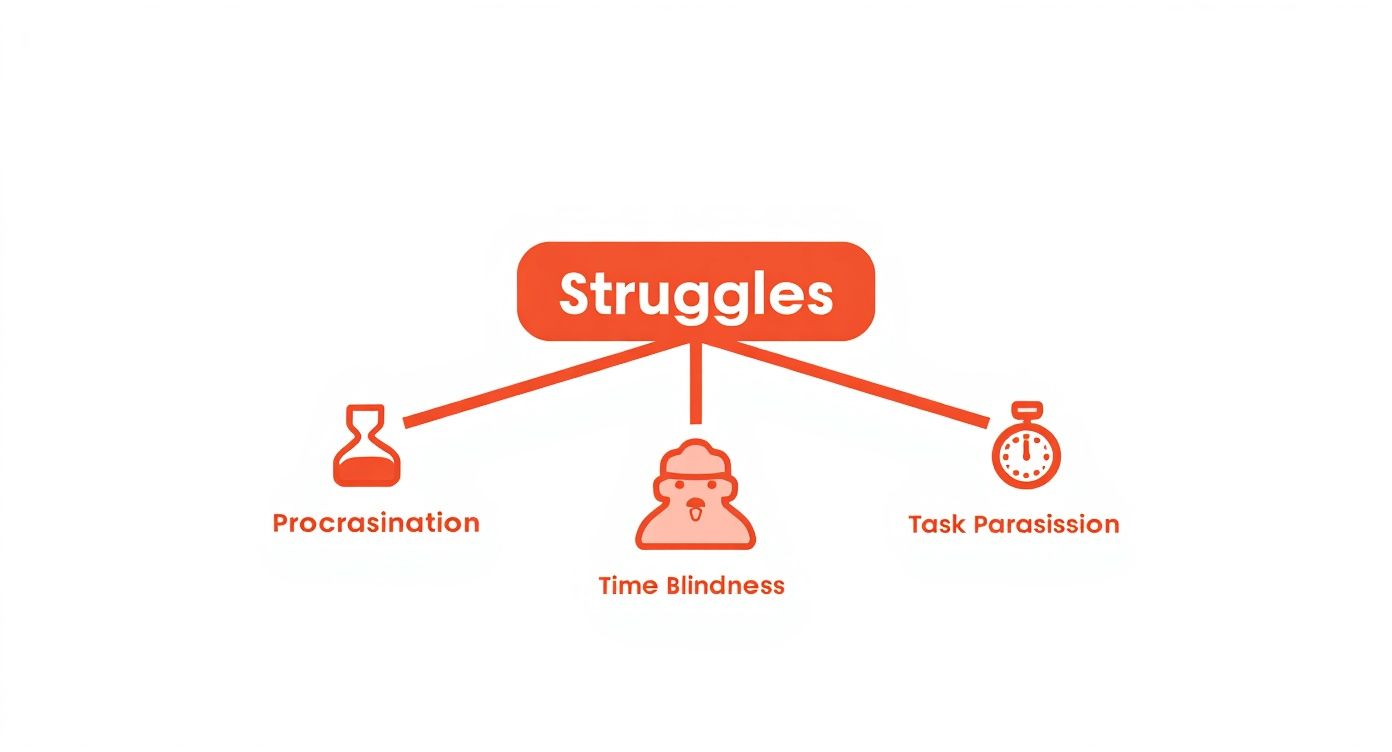It’s a familiar story: you know exactly what you need to do, but for some reason, you just can't do it. This gap between intention and action is incredibly frustrating. If you recognize yourself in this, you're not alone. For many people, especially those with ADHD, this isn’t about a lack of willpower. It's a fundamental difference in how the brain experiences time, which makes most conventional strategies feel like they were designed for someone else entirely.
Why Time Constantly Slips Through Your Fingers

Does this sound familiar? You map out your day with the best of intentions, but by lunchtime, you've been sidetracked a dozen times. Suddenly, it's 5 PM, and the most important things on your to-do list are still untouched.
If you have ADHD, trying to manage time can feel like trying to catch fog with your bare hands. It's a demoralizing cycle that can leave you blaming yourself for being "lazy" or undisciplined.
But here’s the truth: this struggle isn’t a character flaw. It’s a sign that your brain is wired differently. Standard advice like "just use a planner" or "try harder" falls flat because it completely ignores the neurological realities you're dealing with.
The Real Reason Traditional Advice Fails
Most productivity systems are built for neurotypical brains, which have a more intuitive sense of time passing. They operate on the assumption that motivation and prioritization are simple, straightforward skills. But when you're navigating executive function challenges, those are the very things that feel just out of reach.
A perfect example of this is a well-documented experience called “time blindness.” If you’ve ever been shocked to realize hours have passed when it felt like minutes, you know what this is. Want to dive deeper? You can learn more about how to manage time blindness in our detailed guide.
This isn't about lacking the desire to be on time or meet deadlines. It's about a fundamental difference in how your brain processes time, making it hard to estimate how long tasks will take or feel a sense of urgency until a deadline is imminent.
This constant disconnect between what you plan to do and what actually gets done creates a painful loop of stress and self-criticism. But what if you could stop fighting against your brain and start working with it?
A Path Forward Built on Self-Understanding
The first real step toward solving your time management problems is accepting that you need a different kind of toolkit. It all starts with a bit of self-compassion and a genuine curiosity about how your unique brain operates.
Instead of trying to force yourself into a one-size-fits-all box, you can learn strategies that give your brain the external structure and support it craves. This journey is about:
- ✅ Normalizing your experience: Realizing you’re not alone and that millions of others get it.
- ✅ Building self-awareness: Pinpointing the specific patterns that trip you up.
- ✅ Adopting brain-friendly tools: Using techniques actually designed for your neurotype.
Understanding your own challenges is the foundation for creating lasting change. The Inflow app is specifically designed to guide you on this path, providing personalized, science-backed support to build skills and confidence. Ready to see how?
How Your Brain Experiences Time Differently
If you’ve ever felt like your internal clock is running on a totally different schedule from everyone else’s, you’re not just imagining it. For those of us with ADHD, time isn’t just a concept we track; it’s a sensory experience that can feel slippery and wildly inconsistent. This isn't a personal failing. It’s a direct reflection of your brain's unique wiring.
Think of your brain’s executive functions as the conductor of a brilliant orchestra. The conductor’s job is to make sure the violins come in at the right moment, the percussion keeps a steady beat, and everyone plays in perfect harmony to create something beautiful.
Now, with ADHD, that conductor is still incredibly talented. But they might get completely captivated by a fascinating pattern on the ceiling or momentarily lose their place in the sheet music. The result? The musicians start playing out of sync. This is a perfect way to understand why things like meeting deadlines, figuring out what to do first, and managing projects can feel so chaotic. The "musicians"—all your skills and intelligence—are there, but the coordination is the really tough part.
The Science of an Unsynchronized Clock
One of the most common—and frustrating—time management issues linked to ADHD is a phenomenon often called “time blindness.” This is the persistent, nagging difficulty in just sensing the passage of time. You might genuinely believe a task will only take 15 minutes, then look up from your desk to find two hours have completely vanished.
This happens because the parts of the brain responsible for executive functions, like the prefrontal cortex, also help us perceive time. When these functions are less consistent, so is our internal clock. Understanding this can be a massive relief. It changes the story from "I'm just bad at time management" to "My brain needs different tools to perceive time." You can dive deeper into the neuroscience behind the ADHD brain to learn more about these fascinating differences.
🔬 Scientific Takeaway: Time blindness isn't just about being forgetful. Research points to its connection with working memory—your brain’s “sticky note” system for holding onto information you need for a current task. When working memory gets overloaded, keeping track of time gets pushed way down the priority list.
This internal wiring also makes it incredibly hard to gauge future events. A deadline that’s two weeks away can feel like it’s happening in another lifetime, creating absolutely no sense of urgency… until it’s suddenly tomorrow. This isn't procrastination in the classic sense; it's a perceptual challenge. Your brain tends to operate in two main time zones: “Now” and “Not Now.”
Distractions and the Modern Workplace
These neurological differences are only amplified by the modern work environment. The endless stream of emails, Slack notifications, and meeting invites creates a perfect storm for a brain that already struggles to stay on track. In fact, knowledge workers now spend about 88% of their week on communication activities like emails and meetings. That's roughly five hours every single day.
When you're being interrupted every few minutes, and it can take over 20 minutes just to get fully refocused, it's no wonder that the important work gets shoved aside. This constant fragmentation of attention makes it nearly impossible to get into a state of deep work, which is where complex problem-solving happens. It's not just you; it's the environment clashing directly with your neurology.
Recognizing these patterns is the first, most crucial step toward finding solutions that actually work with your brain, not against it. It gives you the power to stop blaming yourself and start building supportive systems.
💡 Try This Gentle Exercise:Before you start your next task, take a moment to guess how long you think it will take. Write it down. Then, set a timer and just do the task. When you're done, compare your guess to the actual time. The goal isn’t to be perfect. It’s simply to build a gentle, non-judgmental awareness of your internal clock, one task at a time.
Common Struggles You Might Recognize
So, we've talked about the science behind executive functions, but what does all that look like in real life? How do these time management problems actually show up day-to-day?
Often, these experiences can feel like personal failures. You might tell yourself you're lazy, undisciplined, or just don't care enough. But that's not what's happening. These are real, observable patterns that come directly from the neurological differences we've been discussing.
Seeing your own habits in these common scenarios can be a huge relief. It’s that "Oh, it’s not just me" moment. This is the first step toward connecting the dots between your brain's unique wiring and your daily struggles, which is exactly where we need to start to find strategies that actually work.
The Five-Minute Task That Never Is
You know the one. You look at a simple chore—answering a quick email, putting away one load of laundry—and think, "This will only take five minutes." But an hour later, you're deep down a rabbit hole on a completely different topic, and the original task is sitting right where you left it.
This isn't a random fluke; it's a perfect storm of executive function challenges.
- Time Blindness: Your internal clock isn't great at guessing how long something will take. More importantly, it doesn't send up a flare when you've blown past your intended time.
- Distractibility: Your brain is a novelty-seeking machine. It gets easily sidetracked by a more interesting thought, a phone notification, or something you just noticed across the room. Answering one email can spiral into reorganizing your entire inbox, which leads to researching a new productivity app, and before you know it, you’re watching a documentary on a subject you can’t even remember how you got to.
This isn't a failure of willpower. It's your attention system doing exactly what it's designed to do—it just doesn't always lock onto the things you want it to.
Task Paralysis: The Agony of Not Starting
Another painfully familiar pattern: task paralysis. It’s that awful, frozen feeling of being unable to start something, even when you know exactly what you need to do. Your to-do list is practically screaming at you, but your brain and body just won't cooperate. It feels like you've hit a mental brick wall.
This is different from simply putting something off. It's a full-on executive function shutdown.
It often kicks in when we feel overwhelmed. If a task seems too big, too boring, or too complicated, the brain’s initiation system can't get the dopamine it needs to get going. The result is a total mental gridlock, where the anxiety about not doing the task just makes it even harder to start.
This is exactly why the advice to "just do it" is so frustratingly useless. Your brain isn't being defiant; it's genuinely stuck. We dive deep into this frustrating cycle in our guide on why people with ADHD procrastinate.
Hyperfocus and the Lost Afternoon
Not all time management issues are about getting distracted from a task. Sometimes, the problem is getting lost in one—usually a low-priority one. This is hyperfocus. You might sit down to quickly check one thing online and snap out of it four hours later, having completely forgotten to eat, drink, or even go to the bathroom.
While it can feel super productive in the moment, hyperfocus often hijacks our best-laid plans. It’s another side effect of having trouble with regulating attention and switching between tasks. Your brain locks onto something stimulating and simply refuses to let go, even when you know other, more urgent things are piling up.
It's like the conductor of your brain's orchestra gets so absorbed in a cello solo that they forget there's a whole symphony waiting to play.
Do any of these sound familiar? If you're nodding along, don't see it as a reason for shame. See it as a moment of clarity. This is the first step toward finding compassionate, brain-friendly ways to move forward.
Practical Strategies That Actually Work With Your Brain
Understanding why your brain struggles with time is a huge, compassionate first step. But let's be honest—that knowledge alone doesn't get the laundry done. Now it's time to shift from understanding the "why" to taking action with practical, evidence-based strategies designed specifically for the ADHD brain.
Forget the generic advice you've heard a million times, like "just focus" or "try harder." These techniques are tools to help you work with your unique wiring, not against it.
Making Time Tangible
For a brain with time blindness, abstract ideas like "45 minutes" can feel completely meaningless. It's just a number. The secret is to make time a physical, sensory experience. This is where visual timers are a game-changer.
Unlike a digital clock that just shows numbers ticking by, a visual timer shows the passage of time in a concrete way. Think of a classic Time Timer where a red disc slowly disappears, or an online version that shows a bar shrinking. This externalizes your internal clock, giving your brain the constant, low-level feedback it needs to stay grounded in the present.
💡 Why it works: Visual timers transform time from an abstract idea into a concrete, visual cue. This dramatically reduces the mental load of having to constantly check the clock, freeing up your brainpower for the actual task.
This visual feedback helps you feel the urgency of a deadline in a calm, manageable way—a huge improvement from the usual last-minute panic when time suddenly "runs out."
The Salami-Slice Method
Ever looked at a huge project and felt so completely overwhelmed that your brain just… shuts down? That's task paralysis. It happens when your brain sees a mountain and decides it’s easier to do nothing at all. The Salami-Slice Method is about turning that mountain into a series of tiny, manageable pebbles.
Instead of putting "write research paper" on your to-do list (which is basically a recipe for procrastination), you break it down into absurdly small steps:
- ✅ Open a new document.
- ✅ Write one sentence for the introduction.
- ✅ Find one academic source.
- ✅ Read the abstract of that source.
Each step is so laughably small that it feels almost effortless to start. This approach cleverly bypasses your brain's overwhelm response by lowering the barrier to entry. Every tiny slice you complete delivers a small dopamine hit, building momentum that makes it easier to tackle the next micro-task. The Inflow app guides you through this process with structured challenges, helping you turn this strategy into a daily habit.
To really see how these common time management problems are connected, just look at the interplay between procrastination, task paralysis, and time blindness.

This map shows how these challenges aren't separate issues but are deeply interconnected, often creating a frustrating cycle that can feel impossible to break.
The Power of Body Doubling
Have you ever noticed it’s way easier to get tedious tasks done when someone else is simply in the room with you? Even if they're working on something completely different? That’s body doubling, and it’s a surprisingly powerful tool.
The quiet presence of another person provides a gentle external pressure that helps anchor your attention and keep you on task. It can be a friend, a family member, or even a virtual group online. This strategy adds a subtle layer of social motivation that can be incredibly effective for getting started and staying focused.
The Two-Minute Rule
Getting started is often the hardest part. The Two-Minute Rule is a brilliant trick to overcome that initial inertia. The rule is simple: if a task takes less than two minutes to complete, just do it immediately.
This applies to all those little things that pile up, like:
- Responding to a quick text.
- Putting a dish straight into the dishwasher.
- Taking out the trash when you see it's full.
By acting on these small items right away, you prevent them from turning into an overwhelming source of clutter—both in your space and in your mind. Each one is a small win that builds momentum for bigger tasks. It also pairs well with other timeboxing methods. To learn about another great technique, check out our guide on the Pomodoro Technique for ADHD productivity.
Modern work environments can often make these time management problems even worse. The average U.S. citizen, for example, works around 1,799 hours per year. Shockingly, studies suggest that up to 60% of those hours are often spent on distracting or less meaningful activities, which only deepens the struggle to stay on task. If you want to free up valuable hours, learning how to automate repetitive tasks and save time can be a huge help, letting you redirect your energy to more impactful work.
How Inflow Helps You Build Lasting Habits
Finally understanding why you struggle with time is a massive relief. But actually turning that lightbulb moment into real, lasting habits? That can feel like trying to jump across a canyon. This is where having a structured, compassionate guide makes all the difference.
Think of the Inflow app as a coach in your pocket—but one that actually gets the ADHD brain. It’s not a magic button, but a supportive tool built to help you practice the very strategies we've been talking about, so they move from ideas on a screen to automatic routines in your life.
Learning That Actually Clicks With Your Brain
If you’ve ever zoned out during dense, academic explanations of ADHD, you’re definitely not alone. The ADHD brain lights up when information is clear, engaging, and something you can use right away. We built Inflow on that exact principle.
The app breaks down the complex neuroscience behind things like executive functions, time blindness, and procrastination into bite-sized, interactive modules you can actually get through.
These short lessons make it easy to understand your own wiring without the confusing jargon. It’s about arming yourself with self-knowledge that feels genuinely useful. You’re not just learning what to do; you're finally understanding why a certain strategy works for you.
Turning Knowledge Into Action
Reading about a strategy is one thing. Remembering to use it when you’re overwhelmed is a whole different ball game. Inflow is designed to bridge that gap with action-oriented challenges and tools that let you practice new skills in a low-pressure way.
- 💡 Guided Skill-Building: The app gives you step-by-step challenges to help you master techniques like the Salami-Slice Method for huge tasks or using timers to make time feel more real. It provides that little bit of external structure your brain craves to build new pathways.
- 💡 Daily Check-ins and Reminders: Gentle nudges and daily planning tools help you stay on track, reinforcing your new routines without adding to your mental load. It’s all about building consistency, one day at a time.
- 💡 A Supportive Community: You also get access to a community of people who are going through the same things. This is huge for accountability and gives you a taste of virtual body doubling, which can make it so much easier to stay motivated and feel way less alone on this journey.
A Personalized Path Forward
Tackling time management challenges isn’t about forcing yourself to operate like a neurotypical person. It's about finding the right tools and support to work with your brain's unique strengths, not against them. Inflow offers a personalized program that helps you zero in on your specific sticking points, whether that's procrastination, staying organized, or managing intense emotions.
It’s a compassionate approach designed to help you build confidence and create routines that actually stick, so you can reclaim your time and energy for the stuff that truly matters to you.
Ready to see how a personalized plan can support your specific needs? Take the Inflow quiz to get started and see how the app can guide you toward building better habits, one small step at a time. Have you noticed how guided practice helps you stick with new skills?
Where Do You Go From Here?
This whole journey of understanding your relationship with time isn't really about finding the perfect planner or the magic app. It's much deeper than that. It's about a fundamental shift in how you see yourself.
If there’s one thing to take away from all this, it's this: Your struggles are real, knowing your brain is your greatest strength, and kind, brain-friendly strategies are what will actually move the needle.
Let that sink in. Building new habits is a marathon, not a sprint, and being kind to yourself along the way isn't optional. The goal was never to erase your ADHD and become some kind of productivity robot. It’s about learning to work with your unique wiring to free up more time and energy for the stuff that actually matters to you.
Progress, Not Perfection
The path to sorting out your time management problems starts with one small, kind step. It's about spotting and celebrating every single win, no matter how tiny it seems.
- ✅ Used a visual timer for one task today? That’s a win.
- ✅ Broke down one massive project into bite-sized steps? Pop the confetti.
- ✅ Gave yourself some grace on a day when it all went sideways? That’s the biggest win of all.
And this isn't just a personal battle; it's reflected in the wider world, too. Think about the workplace. One of the biggest time management issues on a global scale is the shockingly low rate of employee engagement, which kills productivity. Recent data shows that only 21% of workers around the world felt engaged at their jobs. That reality stifles growth for everyone. (You can dig into more employee productivity statistics and their impact on archieapp.co if you're curious.)
Remember: you are not broken. You’re just running a different operating system—one that needs a different user manual. These strategies? They're your new manual.
Your Next Small Step
Feeling seen and understood is the first real step. The next one is taking action. But you don't have to overhaul your entire life by tomorrow morning. Please don't.
Instead, just focus on one small change. Get curious. Experiment gently. Those are your best tools.
The road to better time management is paved with self-awareness and tools that are actually built for a brain like yours. If you feel ready to take that next tangible step, the best place to start is by understanding your own unique patterns.
Take the Inflow quiz today to discover your personalized plan and start building a kinder, more effective relationship with your time.
Got Questions? We've Got Answers
Still have questions about the connection between your brain and your constant battle with the clock? You’re not the only one. Here are a few things that often come up when people start untangling their time management problems.
Can I Have Time Management Problems Without ADHD?
Yes, of course. Life gets messy. Things like chronic stress, burnout, depression, or just being completely overcommitted can throw anyone's time management skills for a loop. It's a universal human struggle from time to time.
The real difference with ADHD is usually the persistence and severity of the problem. It's often a lifelong pattern that pops up everywhere—school, home, work—and never seems to get better, no matter how hard you try. It’s less about one bad week and more about the deep, ongoing hit to your well-being and goals.
The question isn't just, "Do I struggle with time?" It's more like, "Has this struggle been a consistent, frustrating theme my entire life, despite everything I've tried?" If that hits home, it might point to some underlying executive function challenges.
Why Do Traditional To-Do Lists Feel So Awful?
Classic to-do lists are a perfect example of advice built for a neurotypical brain. They expect you to handle a bunch of complex executive functions all at once—prioritizing, sequencing, estimating time, and just starting the thing.
For a brain that finds those skills tough, a long, unstructured list can instantly become a "wall of awful." It’s basically a visual reminder of everything you haven't done, which can kick off a wave of anxiety and lead to a total shutdown. Hello, task paralysis.
💡 ADHD-friendly alternatives work because they externalize those functions. Breaking tasks into tiny micro-steps, using a visual timer, or adding an external motivator (like body doubling) gives your brain the scaffolding it can’t always build on its own.
Is "Time Blindness" A Real Thing?
While you won't find "time blindness" as a formal diagnosis in the DSM-5, it's a very real and widely accepted concept used by clinicians and the ADHD community. It’s a powerful, spot-on way to describe the brain's impaired perception of time passing, which is a core feature of the executive dysfunction that comes with ADHD.
It’s the reason a deadline might not feel urgent until it’s breathing down your neck, or why guessing how long a task will take feels like pulling a number out of a hat. It’s a neurological reality, not a personal failing.
What’s One Small Thing I Can Do Today?
Just start with one thing. Seriously. Pick a single task you've been putting off and set a visual timer for 20 minutes. Don't even worry about finishing it. Your only job is to focus on that one thing for that short block of time.
This tiny experiment helps you feel what it’s like to make time tangible. Just getting through those 20 minutes is a win worth celebrating, and it’s a powerful first step toward building a kinder, more effective relationship with time. The Inflow app can guide you with more of these small, manageable steps to build habits that actually stick.






